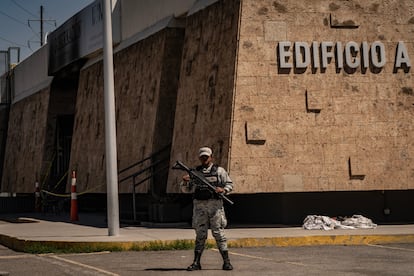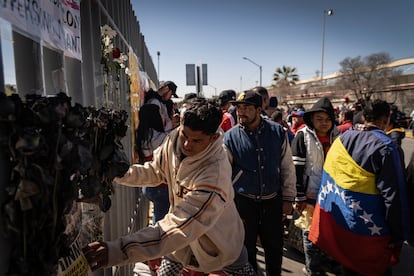Witness to Ciudad Juárez tragedy: ‘They were screaming, banging on the walls’
Viangly Infante, a 31-year-old Venezuelan, was outside the immigration facility waiting for her husband when the fire broke out. ‘They had the chance to open the cells and they didn’t do it. Why didn’t they do it?’


Her hair in an unkempt ponytail and wearing a red fleece, a desperate woman clings to the side of an ambulance, her fists pounding the bodywork, screaming, and clawing at the window. Inside is her husband, one of dozens of people seriously injured during a deadly blaze that ripped through an immigration center in Ciudad Juárez overnight on Monday. Her image was on the front pages of newspapers the following day, in Mexico and overseas: she had become the human face of an inhuman tragedy. At least 39 men have died and 27 more were hurt — many of them are in serious condition — after burning and suffocating inside cells from which nobody managed to release them in time. A few meters from where the fire took place, Viangly Infante says this is no way to gain international fame. Her husband is out of danger, she adds, but she is still asking the same question as dozens of other grieving families: “They had the chance to open the cells and they didn’t do it. Why didn’t they do it?”
Infante, 31, is from Venezuela. She left La Guairá, in the north of the country, on October 6, 2022, becoming one of the seven million Venezuelans who have left their country. She did so accompanied by her three children — two boys aged 12 and 13, and a girl aged one — and her partner, Eduard Caraballo, 26. Together they crossed the perilous Darién jungle, in Colombia, and from there the entirety of Central America until they reached Tapachula, the southern staging point for U.S.-bound migrants in Mexico, on November 1. They crossed the border into the United States at Piedras Negras, a town in Coahuila that merges with Eagle Pass on the U.S. side of the frontier. They were deported on December 22 under the controversial Title 42, a health directive that was invoked by Donald Trump’s administration during the coronavirus pandemic to allow U.S. authorities to expel undocumented migrants to Mexico. Making the same journey as thousands before them, the family arrived in Ciudad Juárez, found work, obtained residency permits and a gained a second opportunity to enter the United States, this time legally.
However, on Monday, immigration authorities in Ciudad Juárez launched a full-scale raid across the border city, netting dozens of migrants in hospitals, on sidewalks, waiting near the border or, as in Caraballo’s case, simply walking the streets. “He had gone out to get medicine for the girl because she has convulsions,” says Infante. At around 2 p.m. she received a call from her husband to say he had been detained at the Mexican National Institute (INM) of Migration facility located between the two main bridges that connect Ciudad Juárez and El Paso in Texas. “They did not let him open his email, where he had his papers saved, so he told me to go upstairs to get the paper copies to prove that we are a family unit and that we are here legally,” she says. “I arrived with my three children and they left me waiting there all day and wouldn’t let him out. They just kept saying ‘yes, right now.’ Until 9:30 p.m. when the fire started.”

Infante and her children were in the family waiting area, a set of white tents on one side of the detention center. She heard the cries of the 68 men locked inside in cells. “They were screaming, banging on the walls. Smoke started coming out. It was everywhere: in the offices, in the bathroom. Everywhere.” The smoke panicked the INM agents who were guarding the 15 women and children in the family area. They decided to take them outside. “I asked what was going on, why weren’t the men coming out, why they weren’t open the fences and the cell doors, and all they could tell me was: ‘They are burning,’” she says.
“I became desperate and started yelling at them. They took me out into the street and left me there. I managed to get close to the fence and saw they were taking out the dead bodies, but I couldn’t see my husband,” she continues, “I was in panic. I went over to the other side of the street and looked in an ambulance and saw that he was inside, that they were resuscitating him: that’s when I became distressed. I started shouting to see if he could hear me. He reacted and sat up. Then they tried to tie him up and I started screaming again, then they took him away.”
That same night, Infante went to the hospital to see her husband. He had been asphyxiated and suffered damage to his eyes, nose, mouth and throat. Over the past 48 hours his condition has improved, but his throat is still so sore that he has barely been able to talk about the “trauma of what he went through in there.”

How was Eduard Caraballo able to escape the inferno alive when so many others did not? Infante does not have the answer. She knows only that was soaked through when he was pulled from the detention center: “He says he locked himself in the bathroom to save himself.” Caraballo was one of the lucky ones. Among his fellow detainees are 16 who are in critical condition, many with serious burns. “They were inside with the fire for 15 minutes until the firefighters arrived and got them out,” says Infante.
The fire is believed to have started inside the cells. The Mexican authorities have stated that the detainees set mattresses alight in protest because they had learned they were going to be deported. The Attorney General’s Office, which is in charge of the investigation, is working on the hypothesis the migrants were able to set the fire by stripping the cables from a surveillance camera, but this has not been confirmed. What is undeniable is that nobody opened the cells in which they were trapped among the flames. Images taken from a camera inside the facility show at least three INM employees leaving the area where the 68 men were being held while smoke billowed, ignoring the pleas of the migrants and their attempts to kick through the cell doors.

Mexico’s Secretary of Security, Rosa Icela Rodríguez, also corroborated this version of events: “When the fire started none of the employees or private police officers took any action to open the doors for the migrants. They were not capable of opening a gate.” Rodríguez has also stated that three officials — two federal and one state — five private security guards and one migrant have been identified over their probable responsibility for the tragedy. Four arrest warrants are expected to be requested on Thursday. Among the crimes being investigated by the Attorney General’s Office are homicide and damage to the property of others.
Sign up for our weekly newsletter to get more English-language news coverage from EL PAÍS USA Edition
Tu suscripción se está usando en otro dispositivo
¿Quieres añadir otro usuario a tu suscripción?
Si continúas leyendo en este dispositivo, no se podrá leer en el otro.
FlechaTu suscripción se está usando en otro dispositivo y solo puedes acceder a EL PAÍS desde un dispositivo a la vez.
Si quieres compartir tu cuenta, cambia tu suscripción a la modalidad Premium, así podrás añadir otro usuario. Cada uno accederá con su propia cuenta de email, lo que os permitirá personalizar vuestra experiencia en EL PAÍS.
¿Tienes una suscripción de empresa? Accede aquí para contratar más cuentas.
En el caso de no saber quién está usando tu cuenta, te recomendamos cambiar tu contraseña aquí.
Si decides continuar compartiendo tu cuenta, este mensaje se mostrará en tu dispositivo y en el de la otra persona que está usando tu cuenta de forma indefinida, afectando a tu experiencia de lectura. Puedes consultar aquí los términos y condiciones de la suscripción digital.
More information
Archived In
Últimas noticias
Imelda Castro, the woman who wants to rule the cartel battleground of Sinaloa
The new victims of the Republican war on Obamacare: Millions hit by soaring health insurance premiums
A country divided on migrant rights: Some US states expand protections while others restrict them
Venezuela authorizes the release of another 87 political prisoners
Most viewed
- David King, chemist: ‘There are scientists studying how to cool the planet; nobody should stop these experiments from happening’
- Reinhard Genzel, Nobel laureate in physics: ‘One-minute videos will never give you the truth’
- Oona Chaplin: ‘I told James Cameron that I was living in a treehouse and starting a permaculture project with a friend’
- Sinaloa Cartel war is taking its toll on Los Chapitos
- World economy in 2026: Three scenarios and a dystopia










































